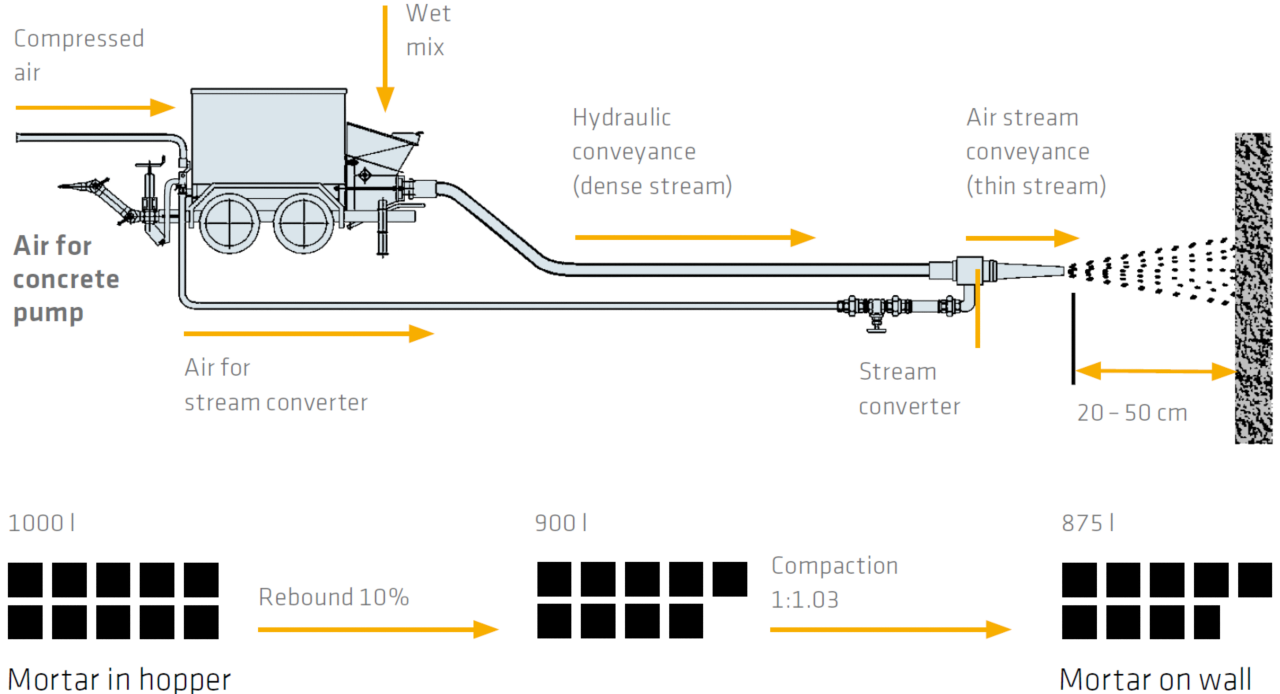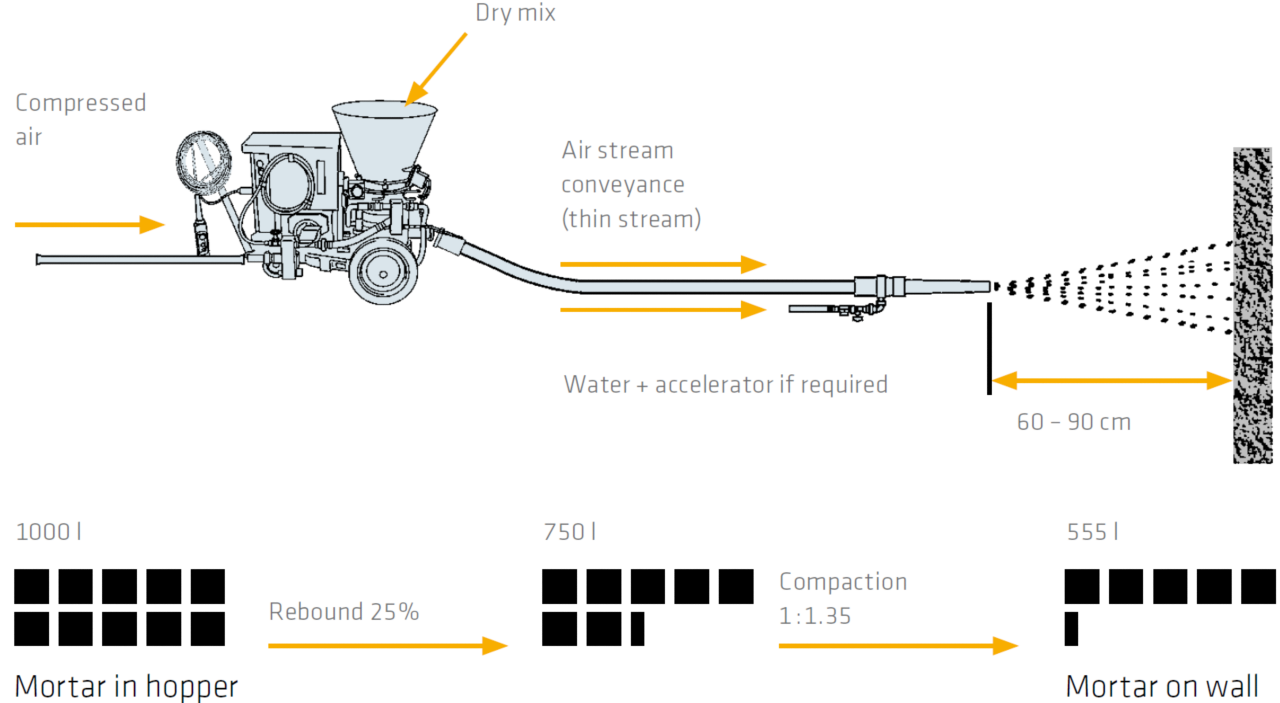Concrete repairs can be conducted with different systems and methods. In the European Standard EN 1504 Part 9, Principle 3 defines the application of repair mortars by machine as well as by hand. In this article you will learn about the advantages of machine application for both dry and wet spray processes. We also give an overview of how to select the right method and equipment for each type of application together with the corresponding Sika materials.
How to Select the Most Appropriate Repair Mortar Application Method?
The evaluation process to decide on the best application method is dependent on different application and performance requirements which can obviously vary greatly on different types of project and from site to site. The following table gives the most important criteria for the contractor to consider and then select the most suitable and efficient application method.
| Criteria | Application Method | ||
|---|---|---|---|
| Machine "Dry" | Machine "Wet" | Hand | |
| Economical aspects: | |||
| Cost efficiency for large repair volumes (>500 kg/day) | *** |
*** | 0 |
| Cost efficiency for small repair volumes (<200 kg/day) | * | * | *** |
| Installation costs | * | * | *** |
| Application aspects: | |||
| Overhead application and extensive thick layer reprofiling | *** | *** | * |
| Compaction behind exposed reinforcement | *** | *** | * |
| Limited working space on site | * | ** | *** |
| Larger transport distance for material | *** | ** | * |
| Environmental aspects: | |||
| Repair under dynamic load | *** | *** | * |
| Dust, noise | 0 | * | *** |
| Technical aspects: | |||
| Bond strength | *** | *** | * |
| Possibility for high early strengths | *** | * | ** |
0 = not suitable; * = possible; ** = good; *** = very good
What are the Benefits of Concrete Repairs by Machine Application?
Machine applied concrete repair is ideal on projects with high repair volumes. The cost efficiency is much better than application by hand and the quality of the hardened repairs is more homogeneous, especially in overhead applications.
Machine application of repair mortars therefore not only brings the benefits of increased output, but it also helps to improve the repair durability. Machine application should be selected over manual application whenever the economic and environmental conditions are appropriate.

Successful Machine Application Is a Result of the Appropriate Equipment Combined with the Right Repair Material
| Equipment |
|---|
| “Wet” Spray Process: Mechanical Mixer
“Dry” Spray Process:
|
| Sika Material |
|---|
Material properties:
|
| Added Value |
|---|
|
Wet vs Dry Spray Processes of Machine Application
WET SPRAY PROCESS ADVANTAGES
- Better yield
- Minimal rebound
- Minimal site protection required
- Suitable for application in confined spaces
- Easy trowel finishing
- Easier QC-procedures
- Reduced dust generation
- These mortars can also be applied by hand
- Constant mortar consistency
HOW IT WORKS
The mortar is first mixed and then fed in a “plastic” consistence and as a dense stream by pump to the point of application. Air is added at the nozzle, which then dissipates the mortar and propels it onto the substrate. Accelerators can not be added at the nozzle.

DRY SPRAY PROCESS ADVANTAGES
- Highest output
- Equipment blockages are rare
- Low equipment cleaning costs
- No premixing required
- No grout priming required
- Higher early strengths
- Long feed distances are possible
- Frequent stop/start sequences are easy
- Thicker layers in a single operation
HOW IT WORKS
The mortar is put into the pump hopper as a dry powder and fed by compressed air in a thin stream to the point of application. At the back of the nozzle the powder is mixed with water, including accelerator if required and propelled to the substrate at a pressure of about 2 bar.
Typical equipment: Aliva AL-246.5 resp. AL-252.1 etc.

Sika Repair Materials Designed for Machine Application
Sika MonoTop®-412 N/S
- Cementitious, one component repair mortar, containing silica fume.
- Outstanding workability and excellent shrinkage behaviour.
- Contains fibres and silica fume.
- Developed specially for the wet spray process, but can also be applied by hand.
Sika MonoTop®-352 NFG/SFG
- Cementitious, polymer modified, one component repair mortar with corrosion inhibitor.
- Excellent application and shrinkage behaviour.
- Additional performance benefits are also obtained from the polymer and corrosion inhibitor (Sika® FerroGard® Technology).
Sikacrete® Gunite-103
- One component, cementitious repair mortar, containing silica fume.
- High build, large volume repair mortar with good workability providing dense, well bonded repairs which can easily be float finished.
SikaCem® Gunite-133
- One component, cementitious, polymer modified repair mortar, containing silica fume.
- Very high build, large volume repair mortar providing dense repairs with excellent bond that can be trowel finished to the highest standards.
- Suitable for use with Cathodic Protection systems, where the slightly higher resistivity will spread current more evenly in overlays of the anodic mesh (ref. Mott MacDonald Report 37423-4/98).
Sikagard®-720 EpoCem®
- Three component, epoxy modified cementitious protective levelling and sealing mortar.
- Thin layer levelling mortar which is suitable for aggressive environments and which needs no additional curing.
Sika MonoTop®-723 N
- Cementitious, polymer modified, one component, pore sealer / finishing coat, containing silica fume.
- Thin layer levelling mortar for horizontal and vertical surfaces.
- Fills surface irregularities and small voids.
SikaTop® Armatec®-110 EpoCem®
- Cement based, epoxy modified, three component material.
- Effective chloride penetration barrier, also provides corrosion protection for steel reinforcement.
- Excellent bonding coat with extended open times for repair mortars.
Sika MonoTop®-910 N/S
- Cementitious, one component material.
- Bonding agent for repair mortars.
- Provides corrosion protection for steel reinforcement.

